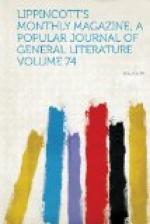We were not comfortable at Perugia—and let no one think to be so until there is a new hotel on a new principle—but it is a place where one can afford to forego creature comforts. Of all the towns on the Tiber, so rich in heirlooms of antiquity and art, none can boast such various wealth as this. The moment one leaves the centre of the town, which is built on a table of rock, the narrow streets plunge down on every side like dangerous broken flights of stairs: they disappear under deep cavernous arches, so that if you are below they seem to lead straight up through the darkness to the soft blue heaven, while from above they seem to go straight down into deep cellars, but cellars full of slanting sunshine. And whether you look up or down, there is always a picture in the dark frame against the bright background—a woman in a scarlet kerchief with a water-vessel of antique form, or a ragged brown boy leading a ragged brown donkey, or a soldier in gay uniform striking a light for his pipe. As soon as you leave the live part of the town, with the few little caffes and shops, and the esplanades whence the thrice-lovely landscape unfolds beneath your gaze, you wander among quiet little paved piazzas with a bit of daisied grass in their midst, surrounded by great silent buildings, whence through some opening you descry a street which is a ravine, and the opposite cliff rising high above you piled close with gray houses overhung with shrubs and creepers, and little gardens in their crevices like weeds between the stones of a wall; or you come out upon a secluded gallery with tall, deserted-looking mansions on one hand—except that at some sunny window there is always to be seen a girl’s head beside a pot of carnations or nasturtiums—and on the other a parapet over which you lean to see the town scrambling up the hillside, while a great breadth of valley and hill and snow-covered mountain stretches away below.
Then what historical associations, straggling away across three thousand years to when Perugia was one of the thirty cities of Etruria, and kept her independence through every vicissitude until Augustus starved her out in 40 B.C.! Portions of the wall, huge smooth blocks of travertine stone, are the work of the vanished Etruscans, and fragments of several gateways, with Roman alterations. One is perfect, imbedded in the outer wall of the castle: it has a round-headed arch, with six pilasters, in the intervals of which are three half-length human figures and two horses’ heads. On the southern slope of the hill, three miles beyond the walls, a number of Etruscan tombs were accidentally discovered by a peasant a few years ago. The outer entrance alone had suffered, buried under the rubbish of two millenniums: the burial-place of the Volumnii has been restored externally after ancient Etruscan models, but within it has been left untouched. Descending a long flight of stone steps, which led into the heart of the hill, we passed through




